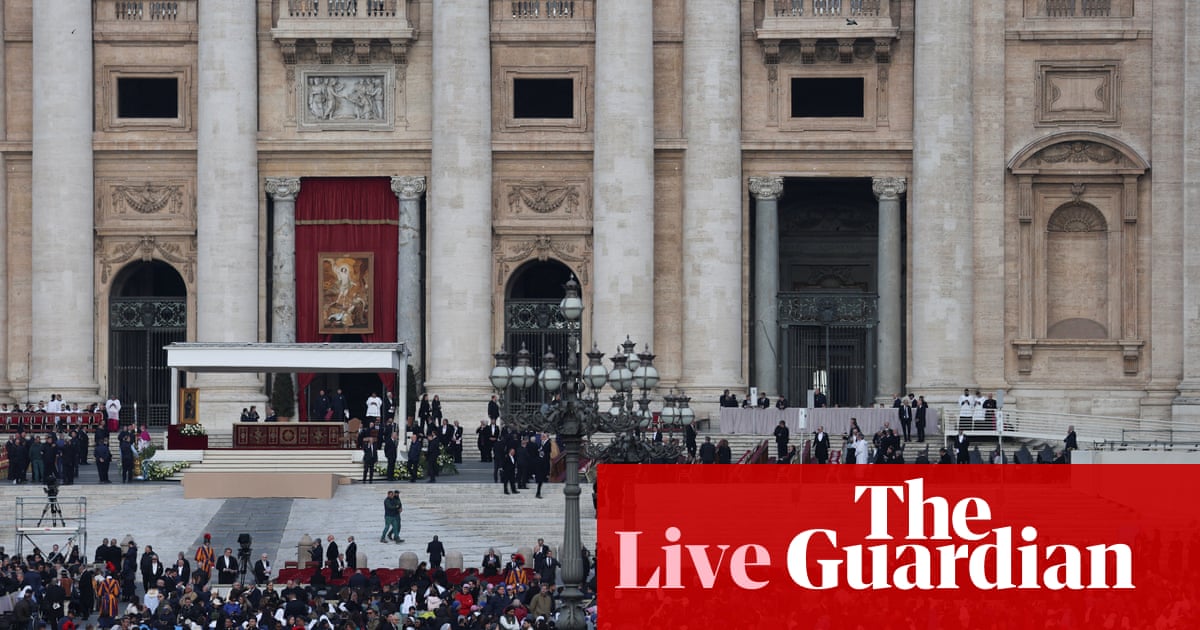The Vaticanon Friday said 150,000 people have already paid their respects toPopeFrancis, whose body lay in state inSt Peter’s Basilicaahead of his funeral.
Between 11am (9am GMT) on Wednesday and midday on Friday, more than 150,000 people had filed past Francis’s body, a Vatican spokesperson said.
The oldest child ofItalianswho migrated toArgentina,Pope Francishad, from the start, made the defence of refugees a cornerstone of his papacy, ensuring in July 2013 thathis first pastoral trip outsideRomewas to the remote island ofLampedusa.
The tiny rocky strip hademerged as a magnetfor smuggling rings bringing people across theMediterraneanfromnorth Africa.
In what would be described as a spur-of-the-moment decision, Francis elected to visit the island in the wake of migrant deaths in a fatal crossing. Residents who cried “viva il Papa” as he was whisked round in an open-topped Fiat voiced incredulity that the Catholic leader would choose to travel to the farthest reaches ofItalyfor an official tour dedicated solely to migrants and refugees.
But the pilgrimage had a goal. For Francis it amounted to the symbolic embrace of something much wider; the beginning of a pontificate that deliberately sought to minister to the marginalised and poor.
In Lampedusa – as inLesbosthree years later – the pope was as determined to express compassion for the living as for those who had died embarking on perilous journeys. “Who wept for these people who were aboard the boat?” he asked during an open-air mass after tossing a wreath into the sea in their memory. “For the young mothers who brought their babies? For these men who wanted to support their families? We are a society that has forgotten how to cry.”
Later he would confide that the tragedy in Lampedusa had “made me feel the duty to travel” in an effort to not only highlight the plight of refugees but “encourage the seeds of hope that are there”.
Serie Ahas postponed its three fixtures on Saturday because ofPope Francis’s funeralbeing held that day inRome. Meanwhile,Italy’s Women’s Six Nationsmatch againstWalesis also expected to be rescheduled as the country prepares to pay its respects.
Earlier media reports in Italy had suggested thatSerie Amight make an exception forInter’s clash with the visitorsRomato allowSimone Inzaghi’s side additional rest time before their midweekChampions League semi-finalatBarcelona. However, the league has confirmed that the game atSan Sirowill now kick off at 2pm (all times BST) on Sunday.
Laziowere to playParmain Rome on Saturday, which has been rescheduled for Monday at 7.45pm, whileComo’s home game withGenoahas been moved to Sunday at 11.30am. Serie A postponed its Easter Monday matches after the pope’s death, with the games rescheduled for Wednesday, and on TuesdayItaly’s National Olympic Committeerequested the suspension of all sporting events scheduled for Saturday.
Pope Francischose to break with the traditions surrounding papal funerals in April last year when he approved a set of simplified rules that allow a pope to be “laid out and buried like any son or daughter of the church”, without the use of an elevated bier topped with cushions. Or, as Francis himself put it:
Papal funerals have traditionally involved three coffins, with the body of the pope placed in a coffin of cypress wood, which is then placed inside one of lead, which, in turn, is put inside a coffin of oak. Francis, however, stipulated that he wanted his body to be placed in a single, simple coffin made of wood and lined with zinc.
Here is a timetable ofPope Francis’s funeral on Saturday and the events to follow. All timings are in local time:
10am:The funeral mass will begin and will be led byCardinal Giovanni Battista Re, the dean of the college of cardinals.
As confirmed by Francis in his final testament, he will be buried at theSanta Maria Maggiore BasilicainRome’sEsquilino neighbourhood, breaking with longstandingVaticantradition.
The public can begin visiting Pope Francis’s tomb at the Roman basilica of Santa Maria Maggiore “as early as Sunday morning”, Vatican spokespersonMatteo Bruniannounced.
A conclave to choose a new pope normally takes place 15 to 20 days after the death of a pontiff, meaning it should not start before 6 May. The exact date will be decided by cardinals after Francis’ funeral.
The funeral ofPope Franciswill be held today atSt Peter’s Square, with a host of world leaders and royals includingKeir Starmer,Emmanuel Macron,Donald Trumpand thePrince of Walesin attendance.
The pope, the head of the world’s 1.4 billion Catholics,died at his home inthe Vaticanon Monday aged 88 after a stroke. He had been recovering from double pneumonia for which he was hospitalised for five weeks.
The funeral mass will begin at 10am local time and will be led byCardinal Giovanni Battista Re, the dean of the college of cardinals, in what is expected to be a solemn ceremony.
In the run-up to Francis’s funeral, tens of thousands lined up to pay their respects to the pope as his body lay in state in an open wooden coffin inSt Peter’s Basilicafrom Wednesday morning. By Friday morning, more than 130,000 people had filed past the coffin.
As confirmed by Francis in his final testament, he will be buried at theSanta Maria Maggiore BasilicainRome’sEsquilino neighbourhood, breaking with longstandingVaticantradition.
He specified that he wanted to be buried “in the ground, without particular decoration” but with the inscription of his papal name in Latin: Franciscus.
The cost of his burial will be covered by a sum provided by a benefactor, which Francis transferred to the basilica, he wrote in his will.
About 50,000 people attended thefuneral of Francis’s immediate predecessor,Pope Benedict, which was also held in St Peter’s Square, in January 2023.
We will bring you updates from Pope Francis’s funeral on this live blog.
